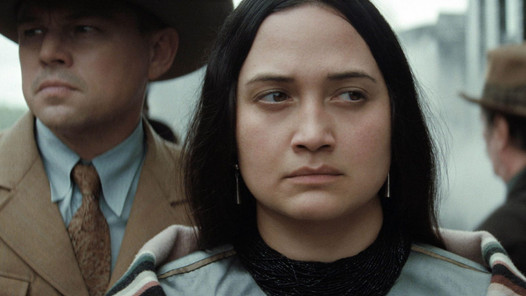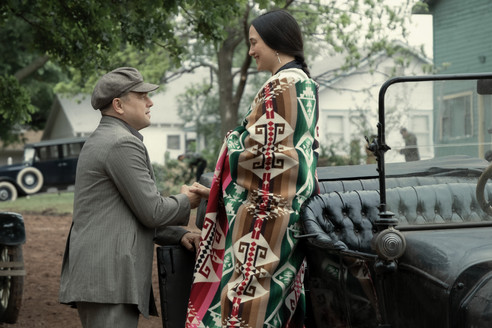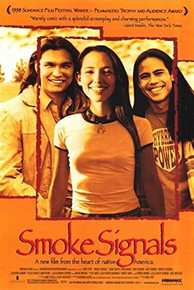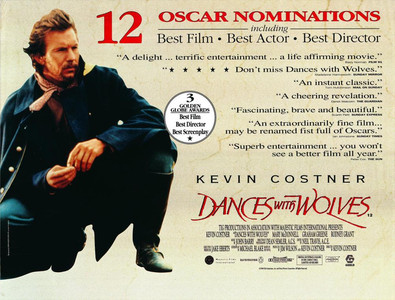Killers of the Flower Moon:"Blood & oil don't mix"
- eclectic Stefan

- Dec 6, 2023
- 11 min read
Updated: Dec 12, 2023

Sagas are bold and wide reaching. They cover the span of generations and the monumental arc of time and events. Killers of the Flower Moon embodies a saga by isolating a slice of the chronicles of an American First Nation, the Osage, and scrutinising the impingement of white society on the Osage during the appropriation of land by white settlers in1920s America.
The movie channels generational connections that spotlight cultural ancestry and historical dislodgement upon one Osage family: Molly, her rebellious sister Anna who adopts and is overcome by the influence of oil wealth, and their mother Lizzie.
It operates in a time when injustice was veiled, obfuscated and condoned by isolation, distance, power, and racism and promoted by the blatant actions of the Klu Klux Klan and secretive Freemasons. It is all draped in culture, traditions, and kinship under an umbrella of corruption, blood, and death.
Official Trailer: Killers of the Flower Moon
© 2023 Paramount Pictures & Apple TV+ Editorial purposes only
In the 1920s, the Native American Osage nation was displaced from their land as white settlers moved West to acquire land for homesteads, grazing pastures and farmland. The Osage wanted to be away from the influence of white people and their dominant cultural imperative. The Osage chose to re-settle on barren land to avoid the onslaught of settlers. Ironically, they were ambushed by the blood of the land—oil—and the cultural disarray that ensued.
The Osage believed useless land would dissuade white settlers and allow the Osage to live their traditional lives uninterrupted. When oil was discovered, the Osage were entangled in the very thing they wanted to avoid, the intrusion of greedy and opportunistic white settlers in the pursuit of wealth at any cost. A further complication was that the Osage owned the rights to any resources on the land they were given, which made them among the richest people in the USA.
Oil was black gold.
Ernest Burkhart (Leonardo DiCaprio) enters the scene as a war veteran seeking a new life and a place to live. He is embraced by his wealthy and influential uncle, William Hale (Robert DeNiro), who infiltrates immediately Ernest’s thoughts and feelings. We learn quickly that Hale’s outward expressions about his direct and beneficent connections with the Osage betray his innermost corrupt notions to cheat them of their oil and land rights.

Burkhart & Hale: power & treachery
The ruling classes in white society and their connections to government and powerful men mean Molly, a Osage woman, has her land rights as a Native American administered by the local white power barons because the federal government labels her officially as “Incompetent”. Therefore, any money she accesses from her oil wealth must be approved by the local administrator.
Furthermore, upon the death of an Osage woman, including Molly, her wealth flows to her husband. Hale is well aware of these legislated conditions and uses it to his and Ernest’s advantage. He encourages Ernest to pursue Molly romantically.
Molly & Ernest: love & betrayal
Ernest and Molly appear to have an attraction that transcends their different cultural perspectives. Molly isn’t a fool or naive. But love eclipses her doubts. Despite Ernest’s sensitive physical and emotional entreaties towards Molly, Molly senses he is, in her own words, a coyote. When Molly’s mother and sister become ill and death beckons, it becomes clear that these deaths are not caused by natural causes and that Hale’s influence with local business leaders, who march openly wearing the trappings of the Klu Klux Klan in parades during public holidays, is substantial.
Inexplicably, Molly, too, becomes ill, supposedly because of her diabetes. Suspicions arise and federal agents, the precursors of the FBI, arrive to investigate the deaths.
Racism is blatant; wealth is abundant; death appears inevitable. The wealth derived from oil sits uncomfortably with the lifeblood of tradition.
Why do Osage wear blankets?
When worn during the I-lo-shka dance, the blanket moves and sways with the dancer, surrounding him or her with a sense of history and tradition. Symbols and use of colors may vary between clans or even families. Horses, like those on this blanket, often symbolise prosperity and may also indicate a family's name.
From The Story of the Wearing Blanket, Denver Art Museum, denverartmuseum.org
From Variety, by Jazz Tangcay, 21 October 2023

The lifeblood of tradition
Killers of the Flower Moon examines how white men, and men is the operative word, decimated Osage customs to appropriate their wealth. The symbolism of Osage people wearing traditional clothing and wrapped in their woven blankets while riding the latest invention, the automobile, is evident. Their pride and history wrap around them in the form of a blanket. It is both a vision of cultural pride and a gauge of their submission to a white cultural standard. As the deaths of Osage women become apparent, male elders, along with the women of the Osage nation, strive to tackle the problem through legal and legislative means.
In Killers of the Flower Moon, physical brutality is both subtle and explosive. The suffering inside each Osage person is indicative of the pulse of their collective lives, their blood like a pulse of generations and the outflow of physical blood that represents the death of identity going back to the days of origins for the Osage people.
Molly is the manifestation of these bloodlines. Oil is the blood of the land; her blood lineage is diminished. He gentleness and sensitivity makes it all the more moving and effective. She is also an architect of her fallibility because she allows her human emotions to lower her shield that tells her to be aware and avoid Ernest. He is both handsome and emotionally clumsy. He hides behind a veil of deceit that will be detrimental to Molly’s life.
Ernst and Molly are representative members of their cultural identity. They are both soul-searching as they discover truths about themselves and the subversion of their identities. Molly’s strength derives from her Osage name, given to her at birth. It’s a name that the Osage say can never be taken away from her or any other Osage.The blood name embodies kin and cultural connections, both physical and spiritual.
The collision of cultures: Hale & Burkhart, Molly & Ernest
Killers of the Flower Moon flows in a gentle pace like the rhythms of the language, including silences, spoken by the Osage people. And silence speaks loudly. Robert DeNiro as William Hale embodies benign evil. He says one thing but betrays the true meaning in the gaps between the words.There are truths that are buried in the characters behaviours and actions.
Osage men and women were not fools. They could see what was happening to them but the power lay with the white administrators. Deniro and DiCaprio both have award winning scowls throughout the movie. The duality of DiCaprio’s character Ernest is about moral prevarication. Ernest is portrayed clearly as a man who loves his wife while being manipulated by William Hale. It is unequivocal that he is slowly killing his wife with the intention of acquiring her headrights. These men were killers. They are allowed a reprieve by Scorsese’s depiction of them as having parts of their hearts that aren’t diabolical.
Killers of the Flower Moon highlights the deliberate mass killings of Native Americans and also depicts Native Americans as victims. Their victimisation eventually leads to them exhibiting their strength by affirming that these deaths must be stopped and condemned with consequences for people such as Hale and Burkhart. Audiences can acknowledge the atrocities but also declare that atrocities are not the only way to remember cultural groups. The Osage’s cultural identity is their strength and pride.
The validity of events depicted in Killers of the Flower Moon is underpinned by Osage cultural and historical information from Osage elders to hopefully provide a cultural foundation to the movie, even though the film can only be an interpretation of events that Scorsese controls and shapes into his movie with his own cultural perspective.
Literally, he sees the events and people surrounding the Osage murders through his lens as an aged, non-Native American Hollywood director. That is not a judgement. He can only present it in his terms. Only an Osage director can bring a different perspective. Scorsese made a considerable effort to engage with and respect Osage elders to bring as much of an Osage perspective as possible. Ultimately, it is a Scorsese movie.
From By Devon Coogan, Entertainment (ew.com), 28 October 2023

Director Martin Scorsese & Osage actor Lily Gladstone (Molly)
Scorsese also displays his immersion in and reverence for American films through outright visual recreations of scenes from Terence Malick’s Days of Heaven, mainly due to Scorsese’s production designer Jack Fisk, who designed sets for Malick's Days of Heaven and now Killers of the Flower Moon for Scorsese. Those references are part of the pedigree of cinema.
The gentle, some might say languid, pace of Killers of the Flower Moon's three and and half hours is indicative of the nature of filmmaking sagas. It could easily be segmented into three or four episodes of a small screen television series. As a long form film, it flows alongside the audience like travelling in a lane on a highway at 40kms an hour rather than travelling in the fast lane at 100kms an hour. You get where you need to get but in a more leisurely pace and without accidents along the way.

All photos, videos & posters ©2023 Paramount Pictures & Apple TV+
Editorial purposes only
FILM EXTRAS
A Deep Dive into Native American Perspectives in Movies & Books
READ (Books)

Bury My Heart at Wounded Knee
Dee Brown's Bury My Heart at Wounded Knee was first published in the United States in 1970. It incorporated a number of eyewitness accounts and official records and offered a scathing indictment of the U.S. politicians, soldiers, and citizens who colonised the American West. Focusing mainly on the thirty-year span from 1860 to 1890, the book was the first account of the time period told from the Native-American point of view.

House Made of Dawn
N. Scott Momaday, a Kiowa Nation poet and author, is often considered the trailblazer behind the Native American Renaissance, thanks to his Pulitzer Prize winning novel, House Made of Dawn, a narrative of a young Native American named Abel who is caught between two worlds—his native heritage on the reservation and the industrialised world of contemporary America in Los Angeles.
WATCH (TV)

Dark Winds (Television series) 2023
Leaphorn and Chee, two Navajo Nation police officers in 1970s Southwest USA are forced to challenge their own spiritual beliefs when they search for clues in a double murder case.
WATCH (Movies)
LINK: Notable Films About Native Americans (from The Culture Trip)
Or
Browse the movies listed below from the article, "Great Films About Native American" in The Culture Trip
GREAT FILMS ABOUT NATIVE AMERICANS
by Sophia White | from The Culture Trip | 28 November 2022
"Hollywood’s racist depictions of Native Americans as savages impeding Manifest Destiny began to fall away after World War II. Broken Arrow (1950) and Apache (1954) paved the way for Cheyenne Autumn (1964) and other films expressing sympathy for the nation’s First People. Here’s a round-up of other likeminded movies".

Little Big Man (1970)
Jack Crabb (Dustin Hoffman), who ages from of 17 to 121 in Arthur Penn’s film of Thomas Berger’s novel, is the prism for a revisionist perspective on the Plains Indians. White orphan Crabb is raised by Cheyennes and marries one, only to witness her murder by Custer’s 7th Cavalry. Enlisted as a scout by Custer, he then sees the Cheyenne and Sioux exact their revenge at the Battle of the Little Big Horn. By telling the story through the eyes of a white captive, Little Big Man offers insights into how prejudice can be turned on its head.

Billy Jack (1971)
Billy Jack features a Navajo protagonist and fights choreographed by the father of the martial art Hapkido. Played by Tom Laughlin, the film’s director and co-writer, ex-Green Beret and Vietnam vet Billy fights for the rights of his fellow Native Americans. Predominantly an action film, it found favour with young moviegoers thanks to its fight scenes – and with hippies for its anti-establishment message. Its 1973 re-release boosted its popularity and it’s now regarded as a cult film. Everyone who sees it remembers the iconic fight at the courthouse and the line ‘I’m gonna take this right foot, and I’m gonna whoop you on that side of your face.’

Windwalker (1980)
Windwalker depicts the life of the eponymous Cheyenne warrior (Trevor Howard) through a series of flashbacks. Toward the end, the deceased Windwalker is reawakened by the Great Spirit to embark on a spiritual journey to reach a peaceful afterlife. Aside from voiceover narration, the entire film is spoken in the Cheyenne and Crow languages. Despite its limited release, Windwalker rose in popularity through word-of-mouth recommendations and was praised for its cinematography and sensitive and positive depiction of Native Americans.

Powwow Highway (1989)
Jonathan Wacks’ boisterous road movie combines the comedy antics of protagonist Buddy Red Bow (A. Martinez) with social commentary on Native American land rights. It thus puts a different spin on the traditional relationship between the Cheyenne and avaricious whites. The story is far from unrelentingly serious: it features comic jail breaks, marijuana trades, and even ‘bromances.’ Powwow Highway won the Sundance Filmmaker’s Trophy and three Native American Film Festival Awards.

Dances With Wolves (1990)
Kevin Costner’s Dances With Wolves is the only film about Native Americans to win the Best Picture Oscar. Heading West after his Civil War heroics, Costner’s former Union Army lieutenant befriends the Sioux and grows to love their ways, though the Army eventually cuts short his sojourn with them. Much of the film’s dialogue is spoken in Lakota or Pawnee. The Director of the Native American Film Festival commented: ‘There’s a lot of good feeling about the film in the Indian community. I think it’s going to be very hard to top this one.’ Indeed, no other movie depicting Native Americans has achieved its fame or popularity.

Geronimo: An American Legend (1993)
Though Walter Hill’s film is based on events leading to the capture of the great Chiricahua Apache leader (Wes Studi) in 1886, it implicitly examines contemporary problems concerning Native American social integration. Unlike other films that negatively depict relation between Native Americans and the US Army, this underrated movie shows a handful of soldiers demonstrating respect and sympathy for the Apache. Native American groups praised it for bringing their people’s pressing concerns to a wide audience.

Smoke Signals (1998)
Cheyenne-Arapaho director Chris Eyre’s debut was the first film made entirely by Native Americans. Adapted by Sherman Alexie from one of his stories, it’s a story of self-discovery. Victor and Thomas, who live on the Coeur d’Alene reservation in Idaho, embark on a road trip that helps them come to terms with their complicated past. Victor (Adam Beach) both loves and despises his abusive alcoholic father, Arnold (Gary Farmer). In contrast, Thomas (Evan Adams) reveres Arnold, who rescued him from a house fire when he was an infant. The film won the Sundance Filmmaker’s Trophy and Audience Award, as well as the Native American Film Festival’s Best Film prize.

Atanarjuat: The Fast Runner (2001)
Zacharias Kunuk’s Atanarjuat – a pioneering adventure tale about a cursed Inuit community, sexual revenge, and warrior endurance – was the first film written, directed, and acted entirely in Inuktitut. Meticulously researched, it was based on a story believed to be at least five centuries old. Changes made to the end of the traditional tale convey a message of hope to the audience. Atanarjuat is one of the best representations of Native American folk history on film.

Skins (2002)
Based on Adrian C. Louis’ novel, Skins tells the story of two very different Lakota Sioux brothers – policeman Rudy (Eric Schweig) and town drunk Mogie (Graham Greene). A witness to widespread unemployment, alcoholism, and impoverishment on their South Dakota reservation, Rudy protests against the exploitation experienced by his people – not least his brother. The film was shot on the Pine Ridge Reservation, the poorest place in the United States. Eyre stated that all the incidents in the film were modeled on real events. Every scene was filmed on an unembellished location to show the grim reality of Pine Ridge’s living conditions.

Imprint (2007)
Produced by Chris Eyre and directed by Michael Linn, Imprint probes enduring Native American beliefs. Supernatural elements aside, it’s primarily about appreciating one’s heritage. Shayla Stonefeather is an attorney who has shunned her Native American background. While prosecuting a Lakota teen in a controversial murder trial, she returns to her dying father’s home for the first time in years and is confronted by spirits who make her re-assess her relationship with her ancestral culture and her spiritual life. Imprint opens a window on the lives of modern Native Americans while showing the endurance of community traditions.



























